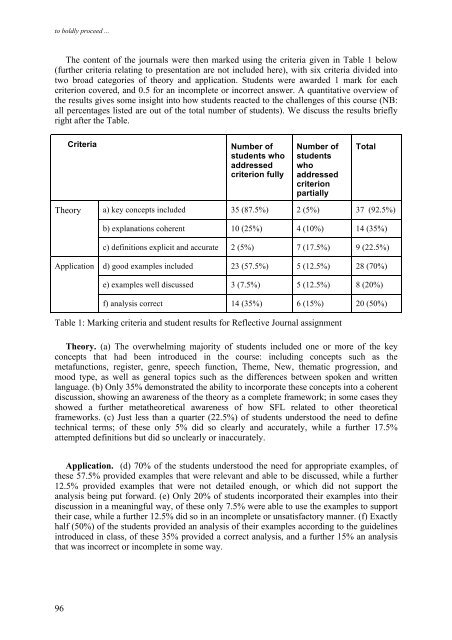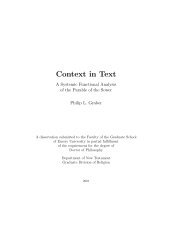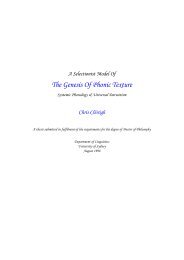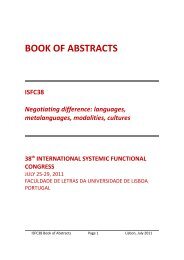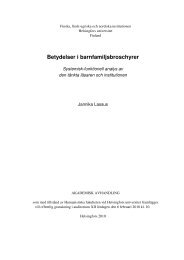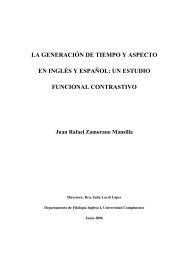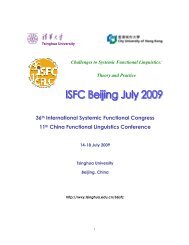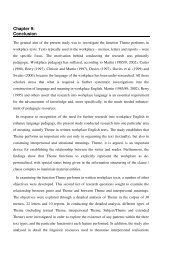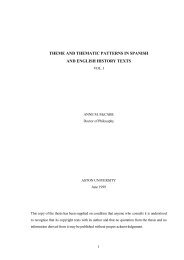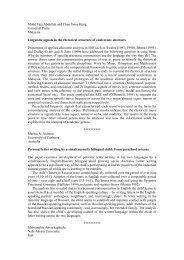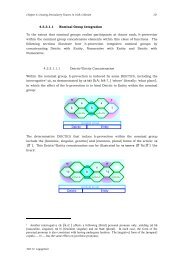the ISFC39 Proceedings - International Systemic-Functional ...
the ISFC39 Proceedings - International Systemic-Functional ...
the ISFC39 Proceedings - International Systemic-Functional ...
You also want an ePaper? Increase the reach of your titles
YUMPU automatically turns print PDFs into web optimized ePapers that Google loves.
to boldly proceed ...The content of <strong>the</strong> journals were <strong>the</strong>n marked using <strong>the</strong> criteria given in Table 1 below(fur<strong>the</strong>r criteria relating to presentation are not included here), with six criteria divided intotwo broad categories of <strong>the</strong>ory and application. Students were awarded 1 mark for eachcriterion covered, and 0.5 for an incomplete or incorrect answer. A quantitative overview of<strong>the</strong> results gives some insight into how students reacted to <strong>the</strong> challenges of this course (NB:all percentages listed are out of <strong>the</strong> total number of students). We discuss <strong>the</strong> results brieflyright after <strong>the</strong> Table.CriteriaNumber ofstudents whoaddressedcriterion fullyNumber ofstudentswhoaddressedcriterionpartiallyTotalTheory a) key concepts included 35 (87.5%) 2 (5%) 37 (92.5%)b) explanations coherent 10 (25%) 4 (10%) 14 (35%)c) definitions explicit and accurate 2 (5%) 7 (17.5%) 9 (22.5%)Application d) good examples included 23 (57.5%) 5 (12.5%) 28 (70%)e) examples well discussed 3 (7.5%) 5 (12.5%) 8 (20%)f) analysis correct 14 (35%) 6 (15%) 20 (50%)Table 1: Marking criteria and student results for Reflective Journal assignmentTheory. (a) The overwhelming majority of students included one or more of <strong>the</strong> keyconcepts that had been introduced in <strong>the</strong> course: including concepts such as <strong>the</strong>metafunctions, register, genre, speech function, Theme, New, <strong>the</strong>matic progression, andmood type, as well as general topics such as <strong>the</strong> differences between spoken and writtenlanguage. (b) Only 35% demonstrated <strong>the</strong> ability to incorporate <strong>the</strong>se concepts into a coherentdiscussion, showing an awareness of <strong>the</strong> <strong>the</strong>ory as a complete framework; in some cases <strong>the</strong>yshowed a fur<strong>the</strong>r meta<strong>the</strong>oretical awareness of how SFL related to o<strong>the</strong>r <strong>the</strong>oreticalframeworks. (c) Just less than a quarter (22.5%) of students understood <strong>the</strong> need to definetechnical terms; of <strong>the</strong>se only 5% did so clearly and accurately, while a fur<strong>the</strong>r 17.5%attempted definitions but did so unclearly or inaccurately.Application. (d) 70% of <strong>the</strong> students understood <strong>the</strong> need for appropriate examples, of<strong>the</strong>se 57.5% provided examples that were relevant and able to be discussed, while a fur<strong>the</strong>r12.5% provided examples that were not detailed enough, or which did not support <strong>the</strong>analysis being put forward. (e) Only 20% of students incorporated <strong>the</strong>ir examples into <strong>the</strong>irdiscussion in a meaningful way, of <strong>the</strong>se only 7.5% were able to use <strong>the</strong> examples to support<strong>the</strong>ir case, while a fur<strong>the</strong>r 12.5% did so in an incomplete or unsatisfactory manner. (f) Exactlyhalf (50%) of <strong>the</strong> students provided an analysis of <strong>the</strong>ir examples according to <strong>the</strong> guidelinesintroduced in class, of <strong>the</strong>se 35% provided a correct analysis, and a fur<strong>the</strong>r 15% an analysisthat was incorrect or incomplete in some way.96


